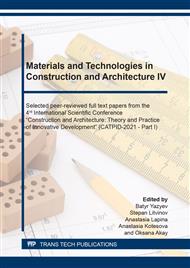[1]
A.P. Merkin, Aerated concrete: scientific and practical prerequisites for further development, Building materials. 2 (1995) 11-15.
Google Scholar
[2]
I.V. Maltseva, Е.V. Maltsev, Use of technogenic waste in the production of cellular materials, Scientific Review. 10-3 (2014) 715-718.
Google Scholar
[3]
L.V. Morgun, V.N. Morgun, P.V. Smirnova, М.О. Batsman, Taking into account the peculiarities of the structure of raw materials in the technology of foam concrete, Theory and practice of production and use of aerated concrete in construction, Sevastopol, (2007).
Google Scholar
[4]
Е.V. Izmalkova, G.А. Tkachenko, The use of soft chalk in the production of aerated concrete, Construction-98: Materials of Intern. conf. Rostov-on-Don, (1998).
Google Scholar
[5]
Е.V. Izmalkova, Structure formation and properties of small-foam concretes with one-stage porosity of the mixture in turbulent mixers: Author's abstract for PhD thesis, Rostov-on-Don, (2000).
Google Scholar
[6]
А.S. Kolomatskiy, S.А. Kolomatskiy, Thermal insulation foam concrete, Building materials. 3 (2002) 18-19.
Google Scholar
[7]
А.B. Steshenko, А.I. Kudyakov, Early structure formation of foam concrete mixture with modifying additive, Engineering- construction magazine. 2 (2015) 56-52.
DOI: 10.5862/mce.54.6
Google Scholar
[8]
V.V. Guseynova, Modification of non-autoclave foam concrete of one-stage preparation with a superplasticizer: Author's abstract for PhD thesis, Rostov-on-Don, (2006).
Google Scholar
[9]
L.D. Shahova, The role of foaming agents in foam concrete technology, Building materials. 4 (2007) 16-20.
Google Scholar
[10]
N. V.Maltsev, Increasing the resistance to sediment of heat-insulating foam concrete mixtures on natural sands and fire-fighting foaming agents: Author's abstract for PhD thesis, Rostov-on-Don, (2004).
Google Scholar


